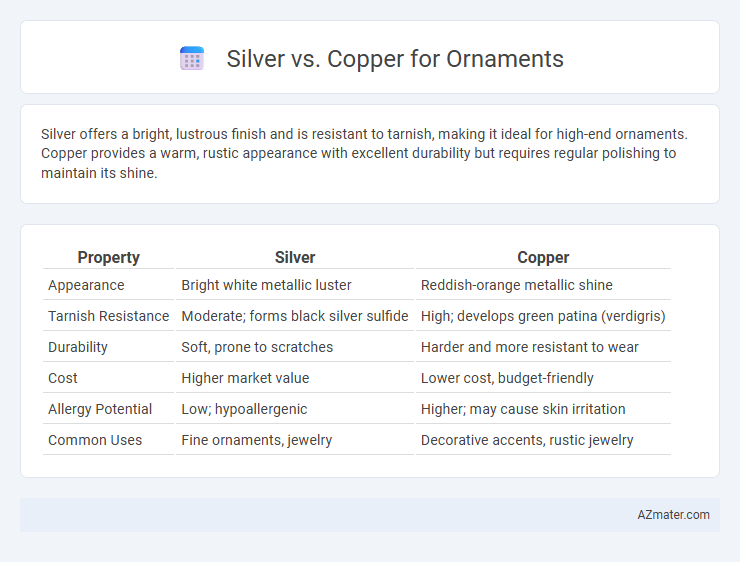Silver offers a bright, lustrous finish and is resistant to tarnish, making it ideal for high-end ornaments. Copper provides a warm, rustic appearance with excellent durability but requires regular polishing to maintain its shine.
Table of Comparison
| Property | Silver | Copper |
|---|---|---|
| Appearance | Bright white metallic luster | Reddish-orange metallic shine |
| Tarnish Resistance | Moderate; forms black silver sulfide | High; develops green patina (verdigris) |
| Durability | Soft, prone to scratches | Harder and more resistant to wear |
| Cost | Higher market value | Lower cost, budget-friendly |
| Allergy Potential | Low; hypoallergenic | Higher; may cause skin irritation |
| Common Uses | Fine ornaments, jewelry | Decorative accents, rustic jewelry |
Introduction to Silver and Copper in Ornamentation
Silver and copper have been pivotal metals in ornamentation for centuries, prized for their unique luster and malleability. Silver offers a bright, reflective shine and is known for its hypoallergenic properties, making it ideal for intricate jewelry designs and luxury items. Copper, with its warm reddish hue, is favored for rustic and vintage styles, providing durability and affordability in decorative crafts and accessories.
Historical Significance of Silver and Copper Ornaments
Silver and copper ornaments hold profound historical significance, with silver often symbolizing wealth, purity, and divine connection in ancient civilizations such as Egypt and Greece. Copper, one of the earliest metals used by humans, was prized for its durability and accessibility, shaping early tools and decorative items prominently in Mesopotamian and Indus Valley cultures. The cultural value of silver and copper ornaments reflects their roles in trade, religious rituals, and social status across diverse societies throughout history.
Material Properties: Silver vs Copper
Silver exhibits superior corrosion resistance and maintains a bright luster longer than copper, making it ideal for ornamental use. Copper offers excellent malleability and affordability but tarnishes rapidly, requiring frequent polishing to preserve its appearance. Both metals conduct heat and electricity well, yet silver's lower reactivity enhances durability in decorative applications.
Aesthetic Appeal and Color Differences
Silver offers a cool, lustrous shine with a sleek, modern aesthetic ideal for minimalist and contemporary jewelry designs. Copper showcases a warm, earthy reddish-orange hue that deepens to a rich patina over time, adding rustic charm and vintage elegance to ornaments. The distinct color contrast makes silver suitable for sleek, polished looks, while copper appeals to those seeking a unique, antiqued aesthetic with natural warmth.
Durability and Longevity Comparison
Silver exhibits superior durability compared to copper due to its resistance to corrosion and tarnish, making it ideal for long-lasting ornamental pieces. Copper, while malleable and aesthetically warm, tends to oxidize over time, developing a green patina that can affect its appearance and structural integrity. Silver's inherent resistance to environmental factors ensures its longevity, maintaining its shine and strength in ornamental use far better than copper.
Tarnish and Maintenance Requirements
Silver tarnishes faster than copper due to its reaction with sulfur compounds in the air, forming a black sulfide layer that requires frequent cleaning to maintain its shine. Copper develops a greenish patina called verdigris over time, which can be polished off but is less common in indoor use and may protect the metal underneath. Maintenance for silver ornaments involves regular polishing with anti-tarnish cloths or solutions, while copper ornaments benefit from occasional cleaning with mild acids or commercial copper cleaners to preserve their luster.
Hypoallergenic Qualities: Skin Reactions
Silver, especially sterling silver, is widely recognized for its hypoallergenic qualities, making it an excellent choice for individuals with sensitive skin or allergies. Copper, while known for its antimicrobial properties, often causes skin reactions such as discoloration or irritation in some wearers, particularly those prone to metal allergies. Therefore, silver is generally preferred over copper for ornaments when prioritizing skin compatibility and minimizing allergic responses.
Cost and Market Value of Silver vs Copper
Silver commands a significantly higher market value than copper, driven by its rarity, conductivity, and demand in jewelry and electronics industries. The cost difference is evident, with silver prices often exceeding copper by more than twenty times per ounce, making silver ornaments a premium choice compared to more affordable, mass-produced copper designs. Market trends show silver's value remains relatively stable or appreciates due to investment demand, whereas copper prices fluctuate more dramatically based on industrial usage and supply dynamics.
Versatility in Design and Craftsmanship
Silver offers greater versatility in design and craftsmanship for ornaments due to its malleability and ability to hold intricate details, making it ideal for delicate patterns and modern styles. Copper, valued for its warm hue and durability, allows artisans to create bold, rustic designs and is often used in handcrafted, vintage-inspired pieces. Both metals provide unique aesthetic qualities, but silver's adaptability suits a wider range of ornamental styles and fine detailing.
Environmental Impact and Sustainability
Silver mining has a significant environmental impact due to the extraction processes, which often involve toxic chemicals like cyanide and mercury, leading to soil and water contamination. Copper mining also poses environmental challenges, including habitat destruction and energy-intensive smelting, but recycling rates for copper are higher, enhancing its sustainability. Choosing recycled silver or copper for ornaments reduces ecological footprints, with copper offering a more circular economy approach given its extensive reuse in industries.

Infographic: Silver vs Copper for Ornament
 azmater.com
azmater.com